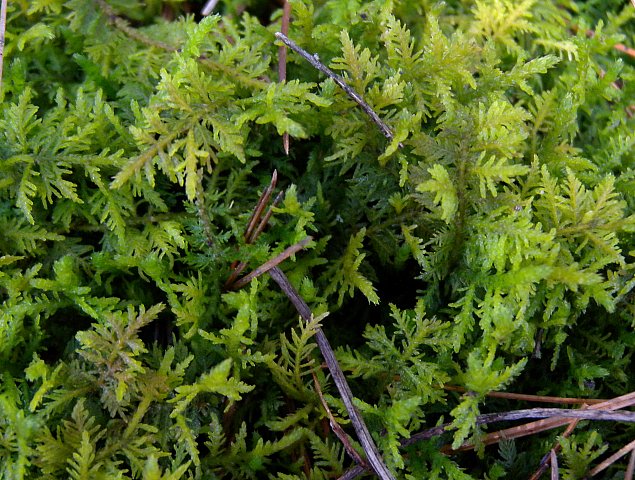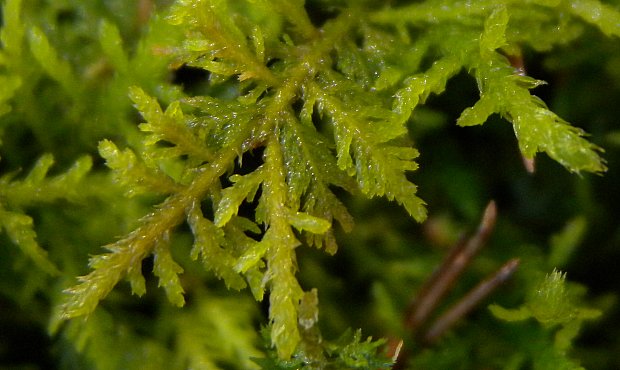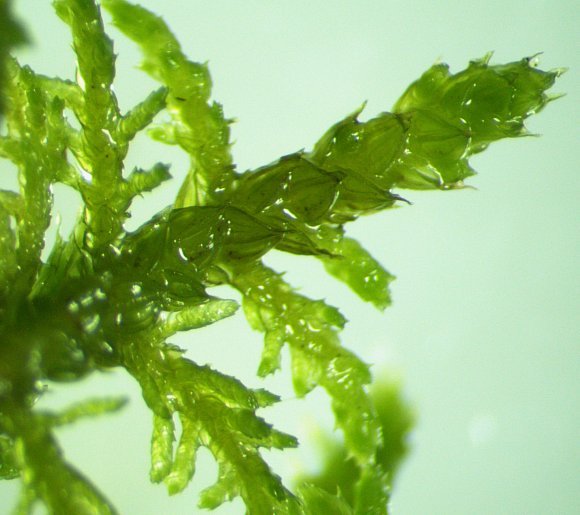
All of these leaves share the same axis (alignment) with their respective central stem or branches, although the leaves diverge somewhat from them when they are moist. Under dry conditions, the leaves are more appressed and contracted against the central stem or branches. Stalks with spore-bearing capsules are produced infrequently from the leaves of this moss. When they occur, the elevated stalks (setae) are 1.5–4.5 cm. long, light green to dull red, terete, and smooth. At the apex of of each stalk, there is a solitary spore-bearing capsule about 2-4 mm. long. This capsule is cylindrical in shape and curved to one side; it has a short-conical lid (operculum) that is covered with a white-membranous long-beaked hood (calyptra). With age, the capsule and its lid change from light green to red and the hood slips off. Then the lid falls from the capsule to release its spores to the wind. The tiny spores are 12-25 microns across, globoid in shape, and smooth. The root system consists of fibrous rhizoids.
Cultivation: The preference is partial sun to medium shade, wet to moist conditions, acidic soil or humus, and some protection from prevailing winds. This fern also grows on rotting logs and weathered sandstone rock in protected areas that are shaded and moist, such as wooded ravines.

Range & Habitat: Common Fern Moss (Thuidium delicatulum) is occasional in the NE, east-central, and southern sections of Illinois, while in the rest of the state it is uncommon or absent (see Distribution Map). It has a wide distribution in North America. Habitats of this moss in Illinois include ground soil and humus in deciduous woodlands, wooded bluffs and hillsides, northern edges of pine groves, tree bases near streams in woods, shaded banks of ravines, shaded creek banks, swampy woods, hummocks in tamarack swamps and typical swamps, shaded areas of sandstone cliffs, the base of sandstone walls, wet sandstone boulders in canyons, and underneath trees in hill prairies along rivers. This moss is found in higher quality natural areas.
Faunal Associations: This moss is often used as construction material for nests by such songbirds as the Barn Swallow, Blue-headed Vireo, Northern Catbird, Cedar Waxwing, Eastern Phoebe, American Robin, Least Flycatcher, Slate-colored Junco, and Prothonotary Warbler (Breil & Moyle, 1976; Blem & Blem, 1994). When colonies of Common Fern Moss (Thuidium delicatulum) are located near streams or pools of water, they are often selected as nest sites by various lungless salamanders, including the Northern Dusky Salamander (Desmognathus fuscus), Allegheny Mountain Dusky Salamander (Desmognathus ochrophaeus), and Four-toed Salamander (Hemidactylium scutatum); see Hom (1987), Forester (1979), and Wood (1955). Common Fern Moss has been found in the digestive tract of a frozen Woolly Mammoth calf in Siberia, although it is unclear if this moss was eaten as a source of food or accidentally while consuming dung (van Geel et al., 2011). Because of its relatively large size and its tendency to form colonial mats, this moss provides protective cover to small vertebrate animals and various invertebrates in shaded wetlands and woodlands.
Photographic Location: Along the northern border of a pine grove at Rock Springs Conservation Area in Macon County, Illinois. The indoor photo was taken with a microscope.

Comments: Common Fern Moss (Thuidium delicatulum), also referred to as Delicate Fern Moss, resembles the fronds of a small fern, except it forms colonial mats of leaves, rather than leafy rosettes. It is one of the more attractive mosses in Illinois. As its common name suggests, Common Fern Moss is the most common species of fern moss (Thuidium) in Illinois. Another species in this genus that is occasionally encountered, Kilt Fern Moss (Thuidium recognitum), can be distinguished by the strongly curved tips of its leaves. Compared to Common Fern Moss, this latter moss also has foliage that tends to be more yellowish. Early botanical collections of Common Fern Moss in Illinois during the 19th century were sometimes misidentified as the Common Tamarisk Moss (Thuidium tamariscinum); see Lesquereux & Potts James (1884). This is primarily a European species, although rare collections of this moss have occurred in Newfoundland and other areas of NE boreal Canada. In the past, fern mosses were used to fill chinks in log cabins, as stuffing for mattresses, and as bedding in cradles and coffins. Today, they are used as packing material, liners for hanging baskets, soil covers for potted plants and terrariums, and for ornamental purposes in moss gardens. Excessive harvesting of such mosses in the wild, however, has the potential to endanger native populations in some areas.